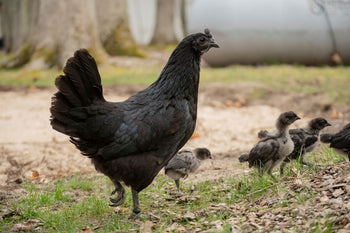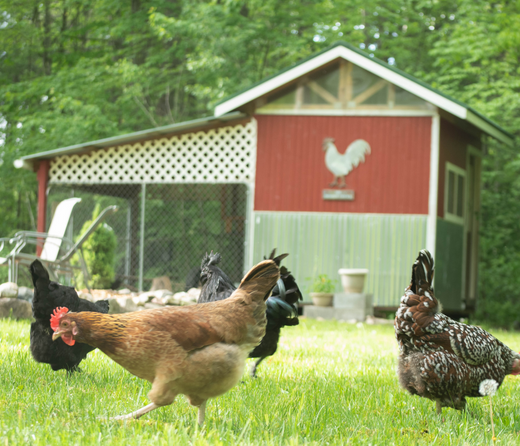At some point in your chicken raising adventure, you’re bound to encounter a broody hen. It can be a strange and startling occurrence! Broody hormones completely change a hen’s disposition and attitude. Your sweet, docile Buff Orpington hen will turn into a growling, hissing ball of feathers when approached. However, you can safely and effectively get your sweet hen back by breaking her of her broodiness, which is actually a lot more humane than it sounds!
What is a Broody Hen?
A broody hen is a hen who decides she wants to hatch eggs and raise chicks. It is a natural, instinctual behavior for hens, though some breeds of chickens are more inclined to go broody than others. Broodiness often occurs in the springtime, when the warming weather and lengthening daylight hours trigger a hormone change in the hen’s body.
However, hens might go broody at any time of the year! It will be hard to miss, but here are a few of the tell-tale signs:
- Stays in the nesting box but stops laying- a broody hen often chooses a nesting box as a safe, dark, protected area to hatch eggs and raise chicks
- Fluffed feathers- when approached, a broody hen will raise up her feathers
- Flattened appearance- a broody hen will flatten herself in the nesting box to cover her eggs as adequately as possible
- Hisses, growls, and pecks- when approached or aggravated, a broody hen will turn aggressive and protective of her nest
- Broody clucks- when off the nest, a broody hen will keep up a series of broody clucks that warns the other flock members not to mess with her
- Broody poop- a broody hen will only leave her nest a couple times a day, and when she does, she will release a huge, stinky broody poop (gross but true!)
- Broody patch- a broody hen will also have a broody patch on her breast where she has pulled out her breast feathers to line the nest with and to expose her moist, bare skin to the eggs for humidity and temperature reasons
When you take a broody hen away from her nest, she may comply for a few minutes and use that time to eat, drink, and relieve herself. Once finished with those tasks, she will insist on returning to her nest regardless of whether there are eggs there or not.

When and Why to Break a Broody Hen
While going broody is a completely natural behavior for hens, it is not always convenient for the chicken keeper or healthy for the hen. If you have hatching eggs or baby chicks, then you may consider using a broody hen. However, if you don’t have chicks or eggs for the hen to tend to, it is best to break her of her broodiness. Breaking a broody hen simply refers to the process of cooling down a broody hen so that she no longer has the broody hormones running throughout her body. Once those hormones lower, the hen will go back to normal and resume laying.
Allowing a broody hen to be broody when she doesn’t have eggs or chicks is not healthy for her. A broody hen will eat less and drink less, causing her to lose weight and become dehydrated. When allowed to stay broody for extended periods, a hen will decline in health.
Sometimes hens will go broody at strange times, like during the winter, too early in the spring, or in the fall. In these cases, it's best to break her of her broodiness to preserve her health. During the winter, a chicken needs to focus all its energy on staying warm and healthy, not being broody and raising chicks. The same goes for early spring, when the temperatures might not be warm enough yet for raising chicks. During the fall, a hen will normally be going into a fall molt and preparing for the winter months. Fall is not the time for a hen to be broody and using up her energy reserves trying to hatch eggs.

How to Break a Broody Hen
The broody hormones cause a hen to become hot, which is helpful when incubating eggs. To break a broody hen, you need to cool her off to cause those broody hormones to lower. The faster you can cool her off, the less time she will spend being broody.
There are many ways you can discourage a hen from continuing to be broody. Some are more efficient than others, depending on the stubbornness of the hen. We tend to find the most efficient method for persistent hens is to use a broody breaker. However, if you don’t think your hen is too determined on being broody, you can try some of the alternative methods mentioned later in this post.
To use the broody breaker method, you need to set up an adequate broody breaker cage, sometimes referred to as a ‘jail’. A broody breaker is a cage or pen that is set up to discourage a hen from wanting to be broody.
A broody breaker should provide food and water for the hen. For flooring, you have several options. Some chicken raisers like to use wire bottom cages, since they are not conducive to nesting and help get air flow on the hen’s breast to cool her down. You can also try using a rough litter like sand, cardboard, or shredded paper as long as the hen doesn’t think she can make a nest with it.
Preferably, the brooder breaker should be located in a somewhat cool location to help the hen cool down. Once the broody breaker is all set up, you can move the broody hen to the broody breaker. The hen will more than likely eat, drink, let off a broody poop and then proceed to panic or pace back and forth in the broody breaker. Don’t give in!
If you let her out, even just for small break, she will immediately go back to her nest and you will be prolonging the period of time she has to stay in the broody breaker.
Make sure the hen as fresh water and food every day. Remove any broody poops, no matter how stinky and gross they are! If the hen manages to make a nest with the litter in the broody breaker, then you should change out the litter to something a little less comfortable.

How Long Does it Take to Break a Broody Hen?
Depending on how persistent the broody hen is, breaking her of her broodiness could take a few days or over a week. You can test the broody hen several times to see if she has returned to normal. Let her out of the broody breaker and see if she insists on resuming her broody tendencies.
Usually when the hen starts eating, drinking, and pooping like normal she is beginning to cool down and the broody hormones are lowering. A hen who has been allowed to be broody for a long period of time may even do a small molt. This is natural, and afterwards she will start laying eggs again.
Once a hen is no longer broody, she can rejoin the flock! If the hen was separated from the flock for an extended period of time, then she may need to be re-integrated into the flock to avoid them bullying her. Re-integration may also be necessary if the broody hen was low in the pecking order.
Alternative Methods to the Broody Breaker
Using a broody breaker is an effective and easy way to cause a broody hen to stop being broody. However, setting one up and caring for the broody hen can be a little time and space consuming. Depending on how broody and persistent the hen is, you can try one of several alternative methods.
Any method that cools a hen down will discourage her from being broody. More specifically, you want to cool down her chest and vent area. Here are some other ways you can discourage a hen from being broody:
- Carry her around- pry the broody hen out of her nesting box and carry her around for a while to let cool air flow under her feathers and onto her breast
- Distract her- again, pry her from the nesting box and place her as far away from the nesting box as possible, then try distracting her with healthy snacks, table scraps, or the opportunity to free-range
- Remove nesting box litter- if it is convenient, you can try removing all the litter from the nesting boxes that way the hen can’t build a comfy nest
- Block the nest and/or the coop- again, if it is convenient you can block access to the nesting boxes or the whole coop to keep the hen away from her chosen nesting area
- Refreshing bath- give the hen a refreshing bath in cool water, the cool water will help lower her body temperature and her wet feathers will distract her for a little while as she preens them dry
Some of these alternative methods may not be very convenient if you have other hens who still need to lay eggs. Methods such as removing the nesting box litter, blocking off the nesting boxes, or blocking access to the coop could stress the other hens out if they haven’t laid their eggs for the day yet.
Two other alternative methods that may work under certain circumstances include daytime quarantine and blocking off access to specific nesting spots.
Daytime quarantine involves putting the broody hen in a chicken tractor or separate pen during the day and blocking off access to the nesting boxes during the night. Sometimes a change of scenery and confinement are all that is needed to discourage a hen from being broody. Just make sure the broody hen has food, water, shade, and protection from predators during the day. At night allow her to go back with the flock but block off access to the nesting boxes. Continue the daytime quarantine until the hen is no longer broody.
Blocking off access only works under certain conditions. If a hen has decided she will be broody in only one certain spot, then you can try blocking off that spot so that she can’t brood in that spot. A lot of hens will simply choose a different spot to brood, in which case daytime quarantine or a broody breaker should be used. However, if a hen wants to nest on the droppings boards in the coop or in a corner of the enclosure, then blocking off those spots may be all it takes to remind her not be broody.
If the alternatives methods don’t work or are not an option, then a broody breaker is your best bet.

It’s the Nice Thing to Do!
While breaking a broody hen may sound a little harsh, if you don't have any chicks or eggs for her to nest on, it is really the best thing for both you and the hen. A broody hen can be fun to have around and watch as she raises her chicks, but when a broody hen is not needed, it is best to discourage her from expending her energy on a fruitless endeavor.


















